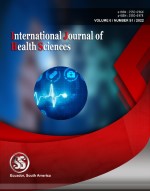Role of orbital exenteration in rhino-orbital-cerebral mucormycosis
Orbital exenteration in mucor “A BOON or A BANE”
Keywords:
ROCM, TRAMB, orbital exenteration, intracranial extension, SION scoringAbstract
Purpose–Mucormycosis is an uncommon, rapidly progressive, commonly fatal, opportunistic serious fungal infection.The high mortality rate highlights the importance of early detection and treatment. The purpose of this study to determine theoutcome of orbital exenteration in Rhino-orbital-cerebral mucormycosis(ROCM) patients. Methods and materials–This study includesall proven ROCM patients who had underwent orbital exenteration based on SION Scoring system from 1st may 2021 to 30 june 2021 in MYH hospital, Indore.Those patients were reviewedand the outcome of orbital exenterationwas analysed. Results- Total 29ROCM patients were underwent for orbital exenteration based on SION Scoring system. 19(65.5 %)out of 29 patients had intracranial extension and 10 (34.480%) did not have intracranial extension.
Out of 29, 6 (20.68%) patients hadsuccumbed to death within 10 days of orbital exenteration was having bilateral orbital involvement with intracranial extension.23(79.34%) patientshave favorable outcome with regular follow up. Conclusion- Survival of mucormycosis patients depends on the their good glycemic control,immune status, laterality of the orbital involvement and early detection of intracranial extensionof the disease.With prompt medical (high dose intravenous amphotericin B) and early aggressive surgical intervention involving FESS and orbital exenteration can preventintracranial extension and may improve survival rate .Intracranial extension of the disease has invariably been associated with high mortality.
Downloads
References
Gamaletsou MN, Sipsas NV, Roilides E, et al. Rhino-orbitalcerebralmucormycosis. Curr Infect Dis Rep 2012;14:423–34.
Chakrabarti A, Das A, Sharma A, et al. Ten years’ experience in zygomycosis at a tertiary care centre in India. J Infect 2001;42:261–6.
Spellberg B, Edwards J, Jr, Ibrahim A. Novel perspectives on mucormycosis: pathophysiology, presentation, and management. ClinMicrobiol Rev 2005;18:556–69.
Ribes JA, Vanover-Sams CL, Baker DJ. Zygomycetes in human disease. ClinMicrobiol Rev 2000;13:236–301.
Ferry AP, Abedi S. Diagnosis and management of rhino-orbitocerebralmucormycosis (phycomycosis). A report of 16 personally observed cases. Ophthalmology 1983;90:1096–104.
Zhou P, Liu Z, Chen Y, et al. Bacterial and fungal infections in COVID-19 patients: a matter of concern. Infect Control Hosp Epidemiol2020;41:1124–5.
Chen X, Liao B, Cheng L, et al. The microbial coinfection in COVID-19. ApplMicrobiolBiotechnol2020;104:7777–85.
White PL, Dhillon R, Hughes H, et al. COVID-19 and fungal infection: the need for a strategic approach. Lancet Microbe 2020;1:e196.
Lehrer RI, Howard DH, Sypherd PS, et al. Mucormycosis. Ann Intern Med 93:93–108, 1980.
Sugar AM. Mucormycosis. Clin Infect Dis 14(suppl 1):126– 129, 1992.
Hosseini SMS, and Borghei P. Rhinocerebralmucormycosis: Pathways of spread. Eur Arch Otorhinolaryngol 262:932– 938, 2005
Hendrickson RG, Olshaker J, Duckett O. Rhinocerebral mucormycosis: a case of a rare, but deadly disease. J Emerg Med. 1999 Jul-Aug;17(4):641-5. doi: 10.1016/s0736-4679(99)00053-0. PMID: 10431954.
13.Dhiwakar M, Thakar A, and Bahadur S. Improving outcomes in rhinocerebralmucormycosis—Early diagnostic pointers and prognostic factors. J LaryngolOtol 117:861–865, 2003
Hargrove RN, Wesley RE, Klippenstein KA, et al. Indications for orbital exenteration in mucormycosis. OphthalPlastReconstrSurg 22:286–291, 2006
MM Roden, et al. Epidemiology and outcome of zygomycosis: a review of 929 reported cases. Clin Infect Dis. 2005 Sep 1;41(5):634-53.
Kashkouli MB, Abdolalizadeh P, Oghazian M, et al. Outcomes and factors affecting them in patients with rhino-orbito-cerebral mucormycosis. Br J Ophthalmol2019;103:1460–5.
Published
How to Cite
Issue
Section
Copyright (c) 2022 International journal of health sciences

This work is licensed under a Creative Commons Attribution-NonCommercial-NoDerivatives 4.0 International License.
Articles published in the International Journal of Health Sciences (IJHS) are available under Creative Commons Attribution Non-Commercial No Derivatives Licence (CC BY-NC-ND 4.0). Authors retain copyright in their work and grant IJHS right of first publication under CC BY-NC-ND 4.0. Users have the right to read, download, copy, distribute, print, search, or link to the full texts of articles in this journal, and to use them for any other lawful purpose.
Articles published in IJHS can be copied, communicated and shared in their published form for non-commercial purposes provided full attribution is given to the author and the journal. Authors are able to enter into separate, additional contractual arrangements for the non-exclusive distribution of the journal's published version of the work (e.g., post it to an institutional repository or publish it in a book), with an acknowledgment of its initial publication in this journal.
This copyright notice applies to articles published in IJHS volumes 4 onwards. Please read about the copyright notices for previous volumes under Journal History.
















